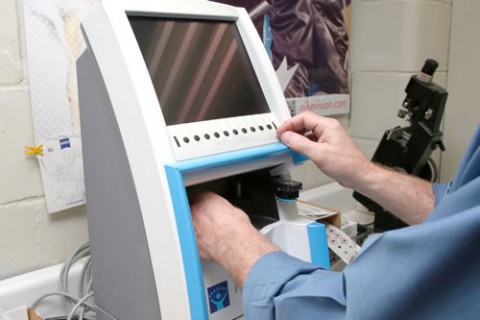On-site eye exams
Your eye exam will start with the optometric assistant taking your information, before seeing the optometrist. If you have been in the office before, they have taken the time to review your last eye vision exam and any pertinent information that was advised by the doctor at that time. As the ocular health is of utmost importance, it is essential that the optometric assistant reviews your health history.
From here, you will have a fundus photograph taken. This technology is absolutely incredible in allowing all of your retinal structures to be viewed with one quick flash of light. If the pupil size is good and the picture quality through the lens of the eye is clear, then this helps alleviate the need for having to put dilating drops in the eyes. There are times that the doctor may need to dilate but in most cases it is not necessary and allows you to return to work without blurry vision. Everyone including children over 10 years of age, diabetics and seniors should have this photo taken at every eye vision exam.
The doctor will perform a vision test to check your vision at distance and at near. There are techniques to measure how well the eyes are working as a team (binocular function) and how well you focus (accommodative testing). Refraction using a retinoscope not only allows the doctor to see what your approximate prescription is but also garners information on how reactive your pupil is and how clear your lens is. After taking all the necessary measurements and involving your subjective input to see which lenses you prefer, a prescription for glasses is now printable. There are many different options in terms of lens design that takes into consideration the distances you work at; generally one pair of glasses will not suffice for all your visual needs.
Health evaluation using a biomicroscope (slit lamp) is the next step in your eye exam. Included in this health portion is glaucoma testing, where intra-ocular pressure is measured. If there are any concerns from the photo, side vision screening, and/or pressure measurement, the doctor will then discuss further testing (such as an OCT scan) and/or referral to an opthalmologist if surgery is required. With the expanded scope of practice for optometry, most conditions are now treatable by your optometrist.
The doctor will then review all of your options (glasses, contact lenses, prescription sunglasses, or further vision testing) and ask if you have any other concerns before referring you to the Optical Boutique.
On-site eye exams or contact lens fittings can be arranged during our regular business hours. Contact us to schedule your next vision care appointment.
On-site vision care lab
Our Vision Clinic is equipped with a state of the art, on-site lab, meaning any service on your glasses can be completed quickly, and your eyewear does not leave the premises.
AA Jones Optical has an on-site finishing laboratory that allows us to insert your prescription into any frame. These are not off-the-rack eye glasses, nor are they sent to an off-site lab for preparation. Customers receiving new glasses frames from A.A. Jones are re-assured with the knowledge that what they have has been crafted and tailor-made to exact requirements using exacting applications.
AA Jones uses Carl Zeiss lenses. Known world-wide, Carl Zeiss is considered one of the best lens manufacturers.

Your world could be a little brighter, more colorful, and safer — just by putting better lenses in your own eyeglasses brand.
More than a century of experience goes into ZEISS lenses. And because everyone’s eyes are different, we want to give you the most individualized vision experience. Whether you’re being fitted for your first pair of single-vision glasses, or making the transition to a progressive lens, ZEISS lens technology allows us to deliver a vision solution to suit your vision problems.
Precision lenses from ZEISS help you achieve precise vision.
Many lens manufacturers offer scratch-resistant or anti-reflective coatings for their products. However, ZEISS invented anti-reflective technology, and with its leading-edge PureCoat® lens process, combines advanced anti-reflective and scratch-resistant technology with an innovative antistatic element that prevents dust and dirt from sticking to the lenses. The lens surface is then sealed with a super-slick top coating that reduces water, oil, and grease, making the lenses exceptionally easy to clean.






